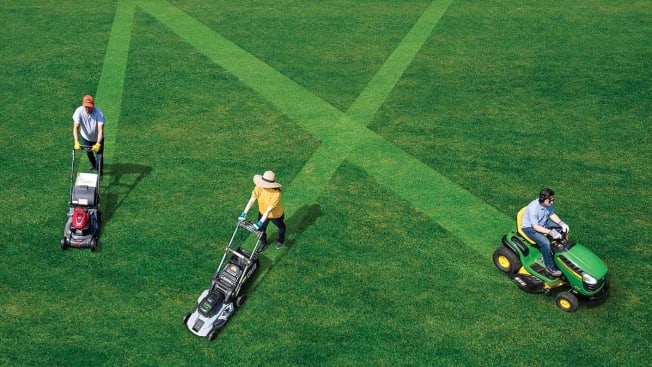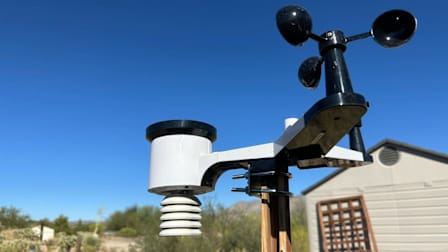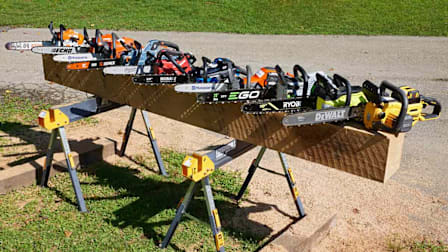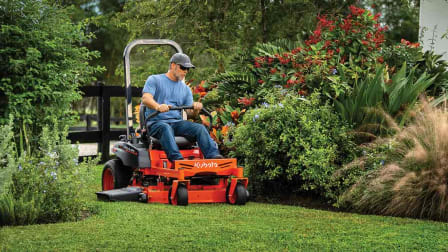A Cut Above: How to Get the Perfect Lawn
CR shares expert advice on yard maintenance to help make your green dreams come true

Americans have long had a love-hate relationship with their yards. Curb appeal and a backyard oasis are considered must-haves for 79 percent of Americans when buying or renting a home, but it costs time and money to maintain a lawn. In fact, it’s the second most important consideration, right behind a newly updated kitchen.
Here, our expert guide to the key tools to have and steps to take.
Go Green Out of the Gate
By May and June, you should have removed leaves and debris, seeded new grass, and fertilized.
Getting a late start? If you live in a northern state, says turfgrass specialist Frank Rossi, Ph.D., at the Cornell University Turfgrass Program in New York, you have an opportunity the rest of the country lacks:
Water Wisely
To keep your lawn hydrated, “water deeply but infrequently,” Rossi says. Programming your sprinkler system to run every day can lead to disease and weed problems.
For more watering precision, Rossi recommends purchasing a soil moisture sensor. These come in two varieties: simple meters you stick in the ground, and wireless sensors that beam data and insights to a smartphone app. Either will indicate whether your lawn needs more water to adequately support plant life.
“Think of the sprinkler as a tool to bridge you until the next rain event,” says Jason Henderson, Ph.D., an associate professor of turfgrass and soil sciences at the University of Connecticut in Storrs. Focus watering on wilted areas, running sprinklers for 15 to 20 minutes in each area. Repeat the process in 30 minutes if the soil is not wet 4 to 6 inches down.
Mow the Right Way
To get the best results from your mower, “sharpen your mower blade at least once a year,” says Frank Spinelli, CR’s lawn mower test engineer. Mowing grass with a dull blade will tear the grass and injure it.
Take the blade to a hardware store or repair shop and have a professional sharpen it. The service typically costs between $5 and $15. (Or purchase do-it-yourself sharpening tools for about $10.)
When it comes time to cut, follow the 30 percent rule. “Never cut off more than 30 percent of the leaf tissue when you mow,” Rossi says. Keep the grass about 3 inches in length because this will allow the roots to grow deep into the soil. What does that look like in terms of frequency? You might end up mowing once every two weeks when growth slows in the hot summer months.
“Let the mower discharge the clippings back onto the lawn, so it can absorb their nutrients,” Henderson says. Those clippings contain a lot of nitrogen—one of three important elements in fertilizer. At the end of each cutting session, wash out the underside of the mower’s cutting deck, which houses the blade. Certain mowers come with a washout port that allows you to connect a garden hose for easy cleaning.
Show Your Mower Some TLC
“If you keep your oil and air filter clean, blades sharp, and replace spark plugs when needed, you’ll find that lawn mowers are almost indestructible,” says Kris Kiser, president and CEO of the Outdoor Power Equipment Institute, an industry group.
But even if your trusty mower is plugging along, you might want to consider an upgrade. “A machine bought today is going to be safer and run cleaner and more efficiently than one bought 20 years ago,” Kiser says.
The Most and Least Reliable Mowers
We asked CR members about their experiences with more than 30,000 walk-behind mowers and 12,000 riding mowers. Here's a look at how 24 brands stack up, across the six most widely sold mower types. (If a brand receives an unfavorable reliability rating of Fair or Poor for a given category, its models in that category cannot be recommended by CR.)
Not all the brands here sell mowers in each category. And for certain brands, we don’t have sufficient data to assign a rating.




















